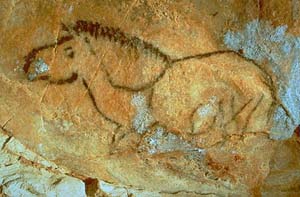
Overview:
. This project is a collaboration between the humanities and digital art departments. The unit is introduced in the humanities class and the online research is done in the digital art computer lab. Students will be researching examples of Early Human cave paintings in order to create their own faux cave paintings.
. Each student receives a copy of the Early Humans task sheet:
http://thebleedingedge.org/features/cave_gallery2/pages/early_humans_worksheet.htm
They are given a time limit (2 - 3 periods, according to your set time constraints and student Internet proficiency) to find the information and make the sketches. The teacher needs to circulate, to help students find the URLs, and demonstrate how to locate the information as efficiently as possible. The sites are so rich that they could spend a month looking through them! They include cave paintings of Lascaux,
Chauvet-Pont-d'Arc, Altamira, and other well-known locations as well as materials from the
Reed Farmstead Archaeological Site. The students have the opportunity to "virtually" discover an actual site, learn about archaeology and how archaeologists work, and reconstruct how our ancestors lived over 150 years ago.
. Students must have a pencil (preferably) or pen in hand to take notes and sketch during the Internet research. The class is instructed to take note of the colors found in the cave paintings (black, browns, ochre, sienna)
. The completed Early Human worksheets are brought to Humanities class for discussion.
. Using their Early Human worksheets as reference, the students create an initial full size comprehensive sketch on scrap paper. In their journal, the students write what their cave painting represents.
. The teacher has prepared brown paper bags, cut to 9" x 12" panels. The brown paper is crumbled and then opened up, so it appears to have rugged appearance, like the wall of a cave.
. The students use charcoal sticks and chalk to sketch in the elements for the cave painting on the brown paper.
. The teacher and a monitor disperse watercolors and brushes to each table. The students are reminded to limit their palette to black, browns, ochre, sienna, so they resemble the real cave paintings.
. After drying, the 21st century cave paintings are exhibited on the classroom bulletin boards. The classmates take turns interpreting one another's work.
The process described above is documented here:
http://thebleedingedge.org/features/cave_gallery2/index.htm
Developed by Meryl Meisler and Grace Raffaele for TeachNet © 2004